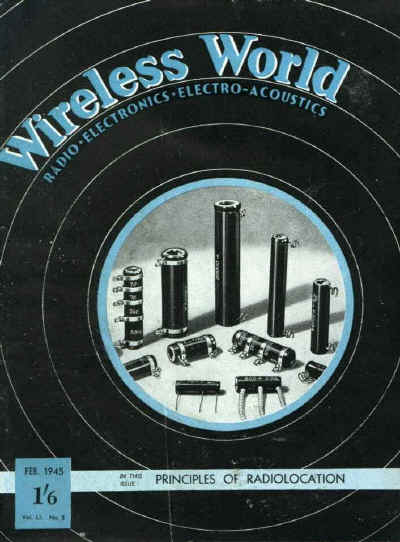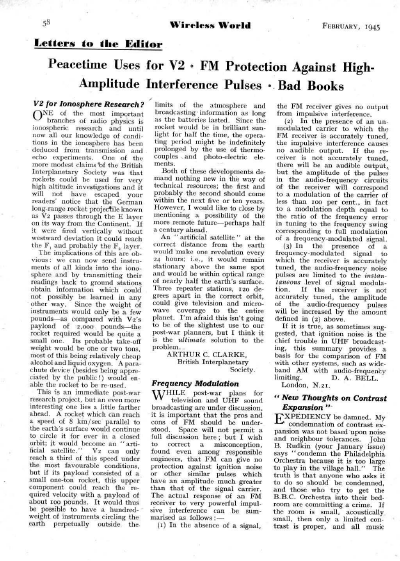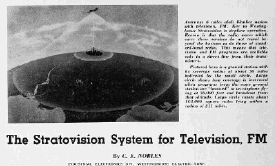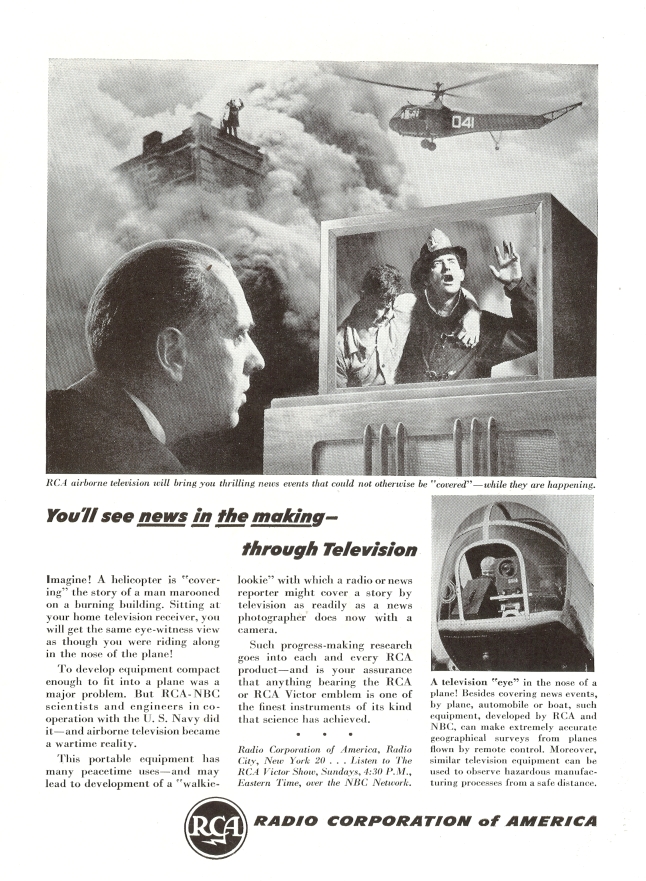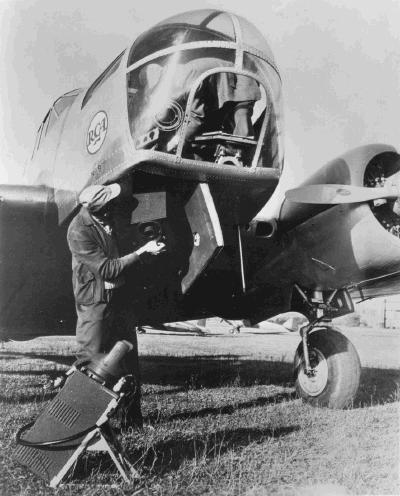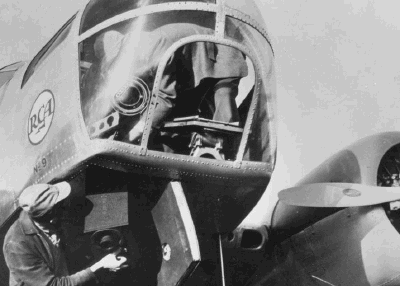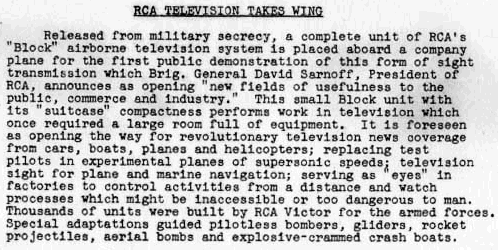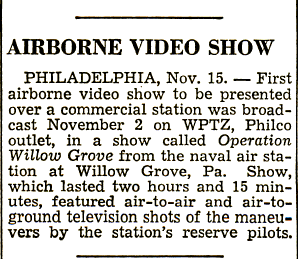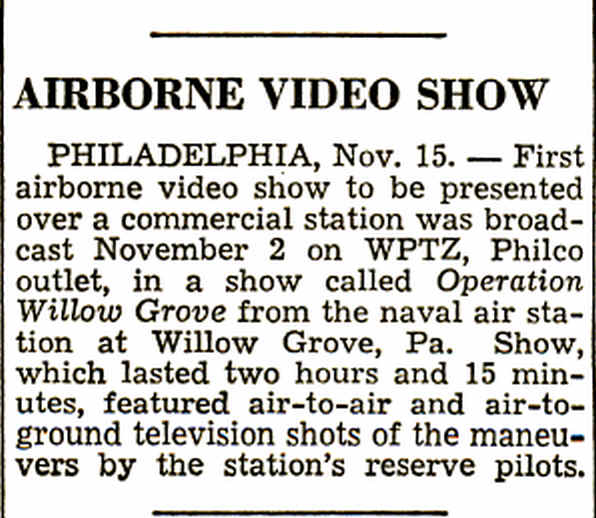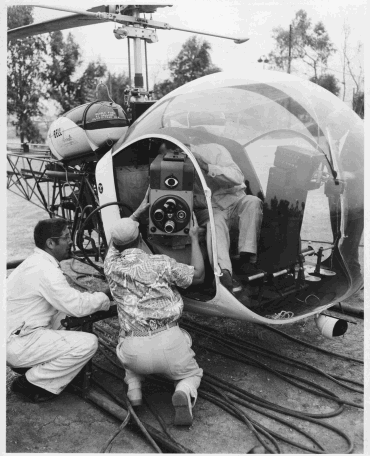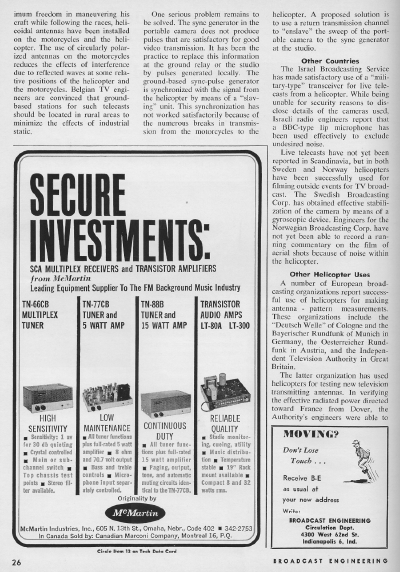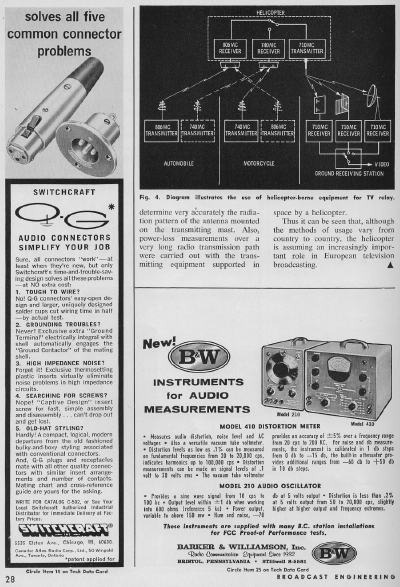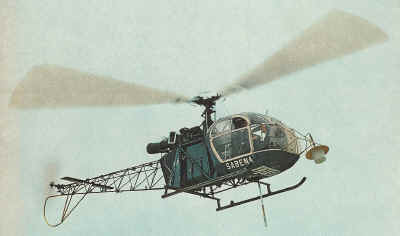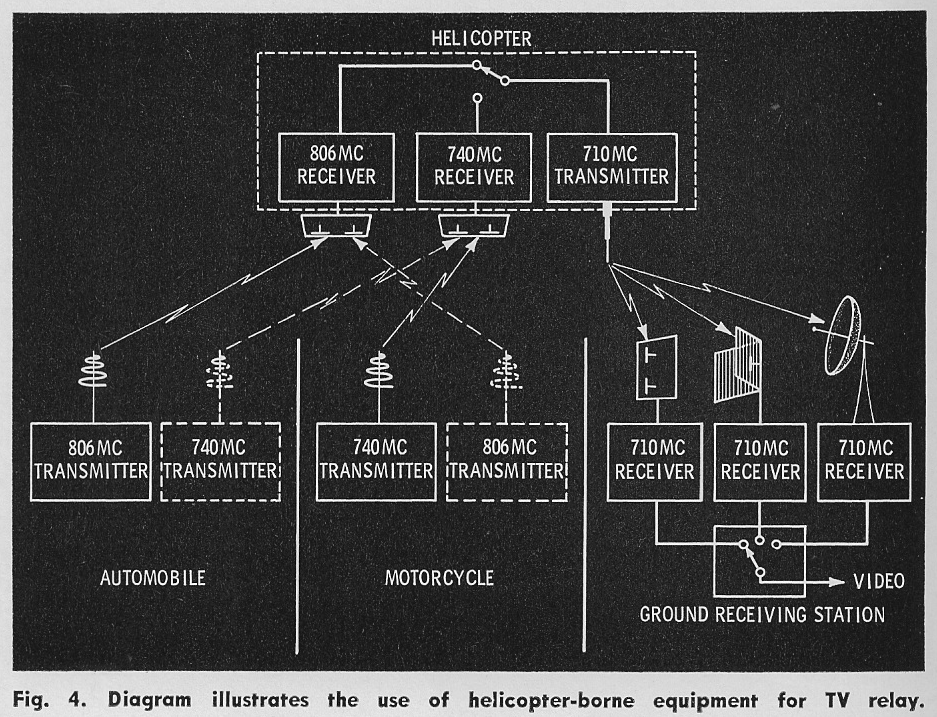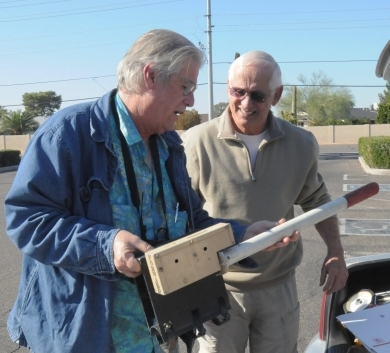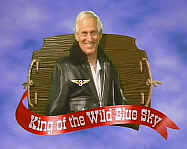|
EYES IN THE SKY: Televising LIVE! Electronic image capturing, reporting
and transmission aloft! |
||||
Ray ForrestRaymond Forrest (January 7, 1916 – March 11, 1999) was a radio staff announcer for NBC, pioneering TV announcer, host and news broadcaster from the very earliest TV era (pre-WW II) through the 1960s. |
March 6, 1940, | |||
| WWII Television
Guided Drone Bomb! THE
BLOCK SYSTEM. Not really for news reporting but significant in
rugged TV transmitter construction techniques.
(info to be added) |
WORLD WAR II | |||
The 1945 Proposal by Arthur C. Clarke for
Geostationary Satellite Communications
|
Feb - July 1945 | |||
|
International Projectionist & Projection Engineering Magazine,
December 1945 (A unique airborne network relay service)
|
December 1945 | |||
|
This was a conception "helicopters will be able to report live news" ad. The plane nose is a real photo but the helicopter and man watching it on TV are artist renderings. Note the plane has a WWII BLOCK system camera in the nose as used by gilded glider bombs from WWII.
In these added official RCA press release
and photographs, you can see
Imagine! A helicopter is "covering" the story of a man marooned on a burning building. Sitting at your home television receiver, you will get the same eye-witness view as though you were riding along in the nose of the plane! To develop equipment compact enough to lit into a plane was a major problem. But RCA- NBC scientists and engineers in cooperation with the U. S. Navy did it-and airborne television became a wartime reality. This portable equipment has many peacetime uses-and may lead to development of a "walkie-lookie" with which a radio or news reporter might cover a story by television as readily as a news photographer docs now with a camera. Such progress-making research goes into each and every RCA product-and is your assurance that anything hearing the RCA or RCA Victor emblem is one of the finest instruments of its kind that science has achieved.
A television "eye" in the nose of a plane! Besides covering news events, by plane, automobile or boat, such equipment, developed by RCA and NBC, can make extremely accurate geographical surveys from planes flown by remote control. Moreover, similar television equipment can he used to observe hazardous manufacturing processes from a safe distance. Radio Corporation of America, Radio City, New York 20 . . . Listen to The RCA Victor Show, Sundays, 4:30 P.M., Eastern Time, over the NBC Network.
RADIO CORPORATION of AMERICA |
Magazine Ad 1946 And additional RCA press release |
|||
|
Nov 22,
1947 |
||||
Newsreel | Operation PegasusNews report on the first live television filming from the air.CHANNEL | BBC Television Service FIRST BROADCAST | 29 September 1950 DURATION | 1 minutes 39 seconds FIRST BROADCAST 1950 SynopsisTelevision takes to the air in this short news report about the first BBC attempt to film Britain aerially, using a Bristol freighter plane, the Giant Brabazon. The test footage of St Paul's Cathedral in London gives us a glimpse of what was included in the programme, which was aired on 1 October. Read about how this disrupted the television schedules. Did you know?The technical difficulties on the test flights included effects
of plane vibration on the camera, radio interference from taxis and
lorries, and the transmission aerials breaking down or not having
enough power. Most of these problems were resolved and the BBC film
crew, RAF and Bristol Aeroplane Company felt that they learned a
great deal about aerial filming from 'Operation Pegasus'. |
Television Goes FlyingThe BBC makes its second attempt to broadcast live from the air.CHANNEL | BBC Television Service FIRST BROADCAST | 22 August 1955 DURATION | 15 minutes 14 seconds FIRST BROADCAST 1955 SynopsisThe first of two experimental broadcasts from a Vickers Varsity
in flight over Norfolk. Cameras from the cockpit and the bomb
aimer's compartment, supplemented by cameras on the ground, capture
the plane taking off and landing, as well as other aircraft, such as
a Lincoln, Canberra and Meteor NF12, flying alongside. Did you know?The Vickers Varsity weighed 15 tonnes and carried half a ton of
equipment on this flight. Power for the camera and sound equipment
actually came from the aircraft itself. The Vickers Varsity was
designed and produced to train pilots, flight engineers, radio
operators, navigators and bomb aimers. The latter were seated in a
very large ventral gondola, which contained bomb aiming equipment
and a small quantity of training bombs. This is where one of the
cameras was positioned. |
1950 Pegasus First Flight |
||
|
In the early or mid 1950's, CBS Engineers place a RCA-TK-30 Camera in a Bell Model ??? Helicopter. The cable is probably 100 feet long and would run down to the camera chain equipment in a remote truck. As long as the truck could reach a point and cable up to the helicopter the camera cable length afforded a high perspective for the television viewers. |
Early or mid 1950's?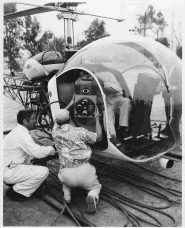 |
|||
KTLA
TELECOPTER - First viable Live Helicopter news reporting platform.
Los Angles Helicopter helicopter changed television news forever.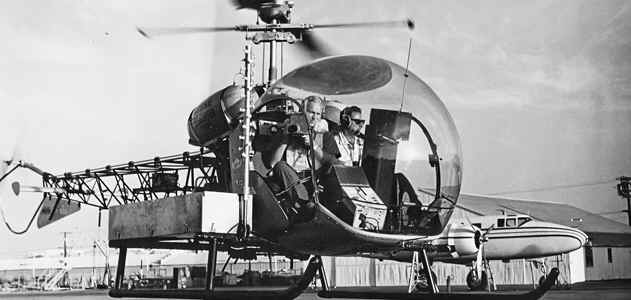 On July 3, 1958 1958 the first TV news helicopter, KTLA’s Telecopter, debuted in L.A. Courtesy John Silva
|
On July 3, 1958 | |||
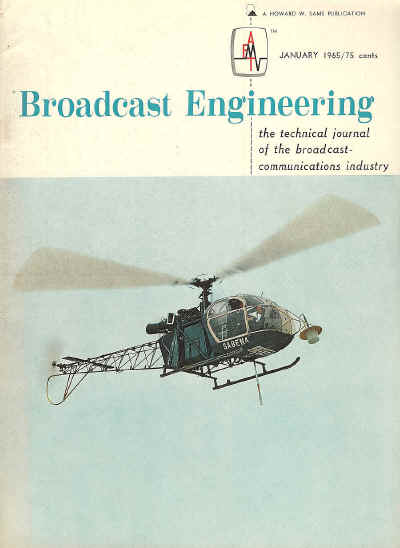

|
||||
| Project
JENNY - Welcome to the Blue Eagle Nest
In October 1965, a US Navy aircraft equipped as an airborne broadcast station performed an airborne radio relay broadcast of the World Series over South Vietnam becoming the worlds first operational airborne broadcast station. In February of 1966, television arrived on the scene in South Vietnam and another new page went into the broadcasting history book. TV shows were broadcast on Channel 11 for AFVN (the American Forces Vietnam Network), and on Channel 9 for THVN TV (the official station of the Republic of Vietnam). TV was broadcast from U.S. Navy NC-121J (Super Constellation) aircraft. These aircraft were known as Blue Eagles and operated as Project Jenny. |
October 1965 | |||
|
News
copter reports
BM/E JULY. 1982 Not all broadcast vehicles are earthbound, and the helicopter manufacturers at NAB bore testimony to the increasing importance of air power. The biggest bird at the show was Bell Helicopter's LongRanger II, seen also... at last year's NAB. This copter is so large that its tail had to be removed to allow it to fit into the booth. A Bell spokesperson described the Long - Ranger lI as the smoothest -flying helicopter Bell makes -a boon when trying to shoot a news story from aloft. It is capable of cruising at 130 mph. A large "ambulance door" allows a stretcher to fit inside (with seats removed, of course) if the station wants to provide some public service during an emergency. (As a company spokesperson noted, proper insurance coverage is a must.) Base price of this top -of- the -line chopper is $495,000, not including electronics. Sharing the Bell booth was ENG Helicopter Satellites Ltd. with its Magic Moment camera mount, seen at previous NAB shows but now in a new version that supports up to 50 lbs. The mount is especially designed to bolt into helicopters, with aircraft -grade hardware throughout. On the small end, Hughes Helicopters was promoting its 300C ENG helicopter, a two- seater piston model that sells in the $200,000 range ($132,000 without electronics). This inexpensive (as helicopters go) chopper is designed to make airborne ENG available to a much larger number of television stations, Hughes states. Also stressing cost -effectiveness was Enstrom Helicopter, which showed a three -seater piston copter with a microwave package from Airborne Microwave Inc. The bird sells for $1 50,000 and the microwave gear adds another $73,000. A spokesperson said that WGN, Chicago, was negotiating a Microwave package for Enstrom bird has Tayburn and BMS components. lease for the helicopter on display. Enstrom will arrange a variety of lease options for its helicopters, as well as lease /purchase arrangements and outright purchases. An attention -getter in the parking lot was the orange Pumpkin Air helicopter, a Bell JetRanger III. The Dallas - area company leases helicopters to stations not yet ready to make the financial commitment of buying a bird. Pumpkin Air will also provide pilots if desired, all with ENG backgrounds, and will equip the helicopter according to the customer's request
|
||||
| (From - May 1982 BM/E) Seventeenth Annual Iris Awards Markets 11-40: KPNX -TV, Phoenix, for "Northland: Sky -12 Country," program executive Robert Allingham and producer John Bass. Other Markets 1 -10: WBZ -TV, Boston, for "Big Boys Can Cry: The Changing American Man," program executive Richard Kurlander and producer Francine Achbar. Markets 11-40: KPNX -TV, Phoenix, for "Northland: Sky -12 Country," program executive Robert Allingham and producer John Bass. Markets 41 -211: KVOS -TV, Bellingham, for "The 1981 Ski -to -Sea Festival Race Highlights," program executive Robert Louis and producer Lynn Rosen. |
||||
| Helicopter showdown in Phoenix
Arizona!
The Duel Between KOOL and KTAR - First Strike - KOOL achieves air to ground live news video and audio transmission via hand held microwave transmitter from their XXXXXX Helicopter piloted by ???? and engineer onboard manning the transmitter was ??? First Practical Live Coverage - KTAR Using the TAYBURN MICROWAVE SYSTEM First in Arizona to report/fly from an effective hi-speed, maneuverable news platform Jerry Foster set records and got news to us. This used a newly developed Tayburn microwave platform that is reputed to be a spin-off of military technology. At the station end there was an autotracking antenna system that would follow Jerry around the valley (and beyond) as he sped about, this system was the secret of what made the Tayburn system so good. In Arizona, KOOL Channel 10 claims a first too. There had been an experimental point to point test incorporating relay transmissions that grant them a claim to a 'first live from a helicopter', but these were limited as they relied on a person holding a microwave transmitter out the window of the helicopter pointed down to a fixed microwave receiver at the ground... then cabled over to the remote truck that would retransmit the signal to the station then to the transmitter site to go out over the airwaves to your house. We also can add that Bill Close and Channel 10 news and engineering crew gloated over pulling this first off... just in a very short time before the SKY-12 Tayburn system was deployed. Did it 10's method work? Yes, a signal was sent... SO... was KOOL First? Yes, first signal - but alas not as practical airborne news platform. Was it usable? Sorta! If everything was connected, aimed properly and you had time to set it all up... an airborne news report could be set to the station Jerry Foster is finishing up his book "EARTH BOUND MISFIT" That will be released at he end of summer. Many questions will be answered and facts explored by Jerry's book. We at SMECC will be putting together not only more info on the Tayburn system from the engineering aspects. Controversial at times? Indeed! Whether you loved or hated him, Pilot/Reporter Jerry Foster helped transform the helicopter industry into what it is today. Enjoy this video segment as Foster breaks his silence in a no holds barred interview on "Flying with Chopper Rose" and takes us on another wild ride down memory lane. Ed Sharpe - Archivist for SMECC
Icon
Pilot/Reporter Jerry Foster
If you get this in email use this link to go to the video http://www.youtube.com/watch?v=gp1gSaMiyYw For Previews of book chapters, interesting stories and some fun photos also check out http://www.sky12.tv/
|
||||
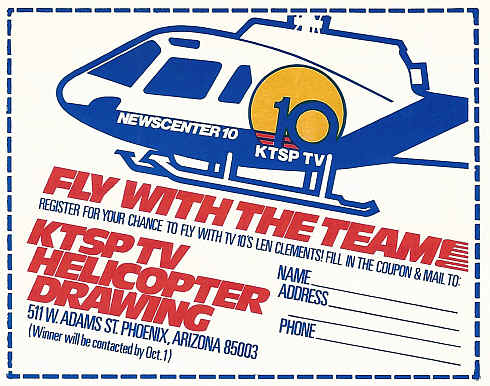
|
||||
| U2 Spy Plane Pilot Francis Gary Powers became an airborne traffic reporter for radio station KGIL Los
Angeles. He was then hired by television station KNBC to pilot their new "telecopter,"
a helicopter equipped with externally mounted 360 degree cameras. Francis Gary Powers died in 1977 in an accident. He was 48 years old. He had been covering brush fires in Santa Barbara County. As he returned, his helicopter ran out of fuel and crashed in the Sepulveda Dam Recreation Area several miles short of Burbank Airport. |
KNBC 1977 | |||
| July 27, 2007 | ||||
